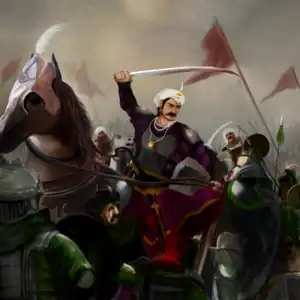| Shiva Simha Singh | |||||
|---|---|---|---|---|---|
| Brahman King of Mithila | |||||
 Modern illustration of King Shiva Singh | |||||
| Reign | 1412 AD - 1416 AD | ||||
| Predecessor | Devasimha | ||||
| Successor | Lakhima Devi | ||||
| Born | Sivasimha | ||||
| Consort | Lakhima Devi | ||||
| Wives |
| ||||
| |||||
| House | |||||
| Father | Devasimha | ||||
| Mother | Hasini Devi | ||||
| Religion | Sanatani | ||||
Shiva Simha Singh was the King of Oiniwar dynasty in Mithila.[1] He is also known as Sivasimha. He was very handsome and highly intelligent, so he was also called as Rūpanārāyana. He was the King of Mithila in India and Nepal. He declared himself to be independent King and stopped paying taxes to Jaunpur Sultanate. Due to his decision to challenge authority of Sharqi empire, Ibrahim Shah Sharqi attacked Mithila and got defeated.
Mithila, Bengal and Arakanese accounts say that brahmin ruler Sivasimha helped another Brahmin ruler, and his friend Raja Ganesha of Bengal, in defeating the Jaunpur Sultanate in Bengal-Jaunpur conflict. Ganesha had previously freed Bengal from Muslim occupation.[2]
Earlier life
King Sivasimha was born in a Mithila Brahmin family. His father's name was King Devasimha. He was the King of Mithila.[3] His mother was Hasini Devi.[4] King Sivasimha was married to six wives. Queen Lakhima Devi was the most famous and scholarly wife of the King Sivasimha. She ruled Mithila from Banauliraj in Nepal for 12 years since 1416 AD to 1428 AD. She sacrificed herself into fire on a Sati ritual, after the 12 years waiting for the King Sivasimha. Padmavati was the eldest wife of the King Sivasimha. She also ruled Mithila for 3 years.
Rule
King Sivasimha ruled the Kingdom of Mithila mainly between 1412 AD to 1416 AD around three years nine months. But he was actively taking part in the administration of the Kingdom from his age of 15 years, when his father Devasimha was alive.[5] He transferred his capital from Devakuli to Gajarathapur ( also known as Shiv Singhpur ) near Darbhanga .[4][6]
Legacy
The people of Mithila remember him for digging several large tanks in several villages of the Kingdom. Among these tanks, the tanks in villages Rajokhari, Barh, etc., are notable which are associated with various proverbs. He issued gold coins. Two specimens of the gold coins were found at Pipra village of Champaran district in 1913. On those coins, there was "Shri" and "Shiva" on the obverse and reverse sides respectively which indicates that the coins belonging to the reigning period of the King Sivasimha. He granted Bisfi village in the present Madhubani district to his friend Vidyapati for his poems Kirtilata and Kirtipataka.[7] He is also said to have erected a Masoleum known as Mamoon Bhanja at Jaruha, near Hajipur.
Wars
In his copper plate grant to Vidyapati, he claimed to have won kings of Gauda and Gajjanpur. He was also involved in Bengal-Jaunpur confrontation.[8]
He led an expedition against Gauda with a view to extending his sway over that part. Sivasimha thought of conquering this newly converted Muslim king. He is said to have defeated Jalaluddin Muhammad Shah, the Sultan of Bengal and annexed some portion of his kingdom while making his region free simultaneously.[9]

Origin of his dynasty
The Oiniwar Dynasty of Mithila was originated from Oini village of Muzaffarpur district in the Mithila region of the present Bihar state in 1324 AD. The period of the dynasty was between 1325 AD to 1695 AD. The first King of the Oiniwar Dynasty was King Nath Thakur. He became King of Mithila in 1324 AD.
References
- ↑ Mishra, Vijayakanta (1953). "Chronology of the Oiniwara Dynasty of Mithila". Proceedings of the Indian History Congress. 16: 200–210. ISSN 2249-1937. JSTOR 44303873.
- ↑ Hussain, Syed Ejaz; Husain, Syed Ejaz (2002). "The Rise of Raja Ganesh in Medieval Bengal and Eaton's Theory of the Crisis of Confidence: A Fresh Study". Proceedings of the Indian History Congress. 63: 272–280. ISSN 2249-1937.
- ↑ "History of Muslim Rule in Tirhut (1206-1765 A.D.)". INDIAN CULTURE. Retrieved 2023-09-16.
- 1 2 Thakur (Ed.), Gajendra. Videha 018 Ist Maithili Fortnightly ejournal मानुषीमिह संस्कृताम् ISSN 2229-547X (in Hindi). Gajendra Thakur.
- ↑ Jha, Makhan (1997). Anthropology of Ancient Hindu Kingdoms: A Study in Civilizational Perspective. M.D. Publications Pvt. Ltd. ISBN 978-81-7533-034-4.
- ↑ Kapoor, Subodh (2002). Encyclopaedia of Ancient Indian Geography. Cosmo Publications. ISBN 978-81-7755-299-7.
- ↑ Dalal, Roshen (2010). Hinduism: An Alphabetical Guide. Penguin Books India. ISBN 978-0-14-341421-6.
- ↑ Mishra, Vijayakanta (1979). Cultural Heirtage Of Mithila.
- ↑ Thakur Upendra. (1956). History Of Mithila (1956). Bhola Nath Mishra Acharya At Sudhakar Press.